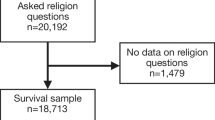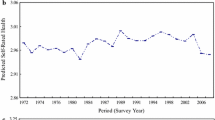Abstract
This paper extends investigation of religiosity and longevity to Taiwan using a 1989 survey: N = 3849, aged 60+, with 18 years of follow-up. Religious activity is measured as worship and performance of rituals. A Gompertz regression, adjusted and non-adjusted for covariates and mediating factors, shows the hazard of dying is lower for the religiously active versus the non-active. Transformed into life table functions, a 60-year-old religiously active Taiwanese female lives more than 1 year longer than her non-religious counterpart, ceteris paribus. Mainland Chinese migrants are examined carefully because of unique religious and health characteristics. They live longer, but the religiosity gap is similar.


Similar content being viewed by others
References
Argue, A., Johnson, D. R., & White, L. K. (1999). Age and religiosity: Evidence from a three-wave panel analysis. Journal for the Scientific Study of Religion,38(3), 423–435.
Bono, G., & McCullough, M. E. (2004). Religion, forgiveness, and adjustment in older adulthood. In K. W. Schaie, N. Krause, & A. Booth (Eds.), Religious influences on health and well-being in the elderly (pp. 163–186). New York: Springer.
Chang, M.-C., & Hermalin, A. I. (1989). 1989 Survey of health and living status of the elderly in Taiwan: Questionnaire and survey design. In Comparative study of the elderly in four Asian countries, Research Report No. 1. Ann Arbor, MI: The University of Michigan.
Chida, Y., Steptoe, A., & Powell, L. H. (2009). Religiosity/spirituality and mortality. Psychotherapy and Psychosomatics,78(2), 81–90.
Davidson, R. J., Kabat-Zinn, J., Schumacher, J., Rosenkranz, M., Muller, D., Santorelli, S. F., et al. (2003). Alterations in brain and immune function produced by mindfulness meditation. Psychosomatic Medicine,65(4), 564–570.
Ellison, C. G., & Levin, J. S. (1998). The relgion-health connection: Evidence, theory, and future directions. Health Education and Behaviors,25(6), 700–720.
George, L. K., Ellison, C. G., & Larson, D. B. (2002). Explaining the relationships between religious involvement and health. Psychological Inquiry,13(3), 190–200.
Hermalin, A. I. (2002). The well-being of the elderly in Asia: A four-country comparative study. Ann Arbor: The University of Michigan Press.
Hidajat, M., Zimmer, Z., Saito, Y., & Lin, H.-S. (2013). Religious activity, life expectancy, and disability-free life expectancy in Taiwan. European Journal of Ageing,10(3), 1–8. https://doi.org/10.1007/s10433-013-0273-9.
Hill, T. D., Angel, J. L., Ellison, C. G., & Angel, R. J. (2005). Religious attendance and mortality: An 8-year follow-up of older Mexican Americans. The Journals of Gerontology Series B: Psychological Sciences and Social Sciences,60(2), 102–109.
Hill, T. D., Ellison, C. G., Burdette, A. M., & Musick, M. A. (2007). Religious involvement and healthy lifestyles: Evidence from the survey of Texas adults. Annals of Behavioral Medicine,34(2), 217–222.
Hummer, R. A. (2005). Commentary: Understanding religious involvement and mortality risk in the United States: Comment on Bagiella, Hong, and Sloan. International Journal of Epidemiology,34(2), 452–453.
Hummer, R. A., Benjamins, M. R., Ellison, C. G., & Rogers, R. G. (2010). Religious involvement and mortality risk among pre-retirement aged US adults. In C. G. Ellison & R. A. Hummer (Eds.), Religion, families, and health: Population-based research in the United States (pp. 273–291). New Brunswick, NJ: Rutgers University Press.
Hummer, R. A., Rogers, R. G., Nam, C. B., & Ellison, C. G. (1999). Religious involvement and US adult mortality. Demography,36(2), 273–285.
Idler, E. L., Musick, M. A., Ellison, C. G., George, L. K., Krause, N., Ory, M. G., et al. (2003). Measuring multiple dimensions of religion and spirituality for health research: Conceptual background and findings from the 1998 General Social Survey. Research on Aging,25(4), 327–365.
Iwasaki, M., Otani, T., Sunaga, R., Miyazaki, H., Xiao, L., Wang, N., et al. (2002). Social networks and mortality based on the Komo-Ise cohort study in Japan. International Journal of Epidemiology,31(6), 1208.
Kinsella, K., & Phillips, D. R. (2005). Global aging: The challenge of success. Population Bulletin,60(1), 1–40.
Koch, C. (2013). The brain of Buddha. Scientific American Mind,24(3), 28–31.
Koenig, H. G. (2001). Religion, spirituality, and medicine: How are they related and what does it mean? Mayo Clinic Proceedings,76(12), 1189–1191.
Koenig, H. G. (2013). Is religion good for your health? The effects of religion on physical and mental health. New York: Routledge.
Krause, N. (2002). Church-based social support and health in old age exploring variations by Race. The Journals of Gerontology Series B: Psychological Sciences and Social Sciences,57(6), S332–S347.
Krause, N., & Booth, A. (2004). Religious influences on health and well-being in the elderly. New York: Springer.
Krause, N., & Hayward, D. R. (2014). Hostility, religious involvement, gratitude and self-rated health in late life. Research on Aging,36(6), 731–752.
Lawler-Row, K. A., & Elliott, J. (2009). The role of religious activity and spirituality in the health and well-being of older adults. Journal of Health Psychology,14(1), 43.
Ledesma, D., & Kumano, H. (2009). Mindfulness-based stress reduction and cancer: A meta-analysis. Psycho-Oncology,18(6), 571–579.
Levin, J. S., & Chatters, L. M. (2008). Religion, aging, and health: Historical perspectives, current trends, and future directions: Public health. Journal of Religion, Spirituality & Aging,20(1–2), 153–172.
Levin, J. S., Taylor, R. J., & Chatters, L. M. (1994). Race and gender differences in religiosity among older adults: Findings from four national surveys. Journal of Gerontology,49(3), S137–S145.
Liu, E. Y., Schieman, S., & Jang, S. J. (2011). Religiousness, spirituality, and psychological distress in Taiwan. Review of Religious Research,53(2), 137–159.
Lutz, A., Slagter, H. A., Dunne, J. D., & Davidson, R. J. (2008). Attention regulation and monitoring in meditation. Trends in Cognitive Sciences,12(4), 163–169.
Marmot, M. (2005). Social determinants of health inequalities. The Lancet,365(9464), 1099–1104.
Mineau, G., Smith, K. R., & Bean, L. (2004). Adult mortality risks and religious affiliation. Paper presented at the Annales de démographie historique.
Moreira-Almeida, A. (2013). Religion and health: The more we know the more we need to know. World Psychiatry,12(1), 37–38.
Neugarten, B. L., Havighurst, R. J., & Tobin, S. S. (1961). The measurement of life satisfaction. Journal of Gerontology,16, 134–143.
Nicholson, A., Rose, R., & Bobak, M. (2010). Associations between different dimensions of religious involvement and self-rated health in diverse European populations. Health Psychology,29(2), 227–235.
Penninx, B. W., Van Tilburg, T., Kriegsman, D. M., Deeg, D. J., Boeke, A. J. P., & van Eijk, J. T. M. (1997). Effects of social support and personal coping resources on mortality in older age: The Longitudinal Aging Study Amsterdam. American Journal of Epidemiology,146(6), 510–519.
Phillips, R. L. (1975). Role of life-style and dietary habits in risk of cancer among seventh-day adventists. Cancer Research,35(11), 3513–3522.
Pirutinsky, S., Rosmarin, D. H., Holt, C. L., Feldman, R. H., Caplan, L. S., Midlarsky, E., et al. (2011). Does social support mediate the moderating effect of intrinsic religiosity on the relationship between physical health and depressive symptoms among Jews? Journal of Behavioral Medicine,34(6), 489–496.
Radloff, L. S. (1977). The CES-D Scale: A self-report depression scale for research in the general population. Applied Psychological Measurement,1(3), 385–401.
Seybold, K. S., & Hill, P. C. (2001). The role of religion and spirituality in mental and physical health. Current Directions in Psychological Science,10(1), 21–24.
Strawbridge, W. J., Shema, S. J., Cohen, R. D., & Kaplan, G. A. (2001). Religious attendance increases survival by improving and maintaining good health behaviors, mental health, and social relationships. Annals of Behavioral Medicine,23(1), 68–74.
UNFPA, & HelpAge International. (2012). Ageing in the twenty-first century: A celebration and a challenge. New York: United Nations Population Fund and Help Age International.
United Nations. (2016). World population prospects: The 2016 revision. New York: United Nations.
Yeager, D. M., Glei, D. A., Au, M., Lin, H.-S., Sloan, R. P., & Weinstein, M. (2006). Religious involvement and health outcomes among older persons in Taiwan. Social Science and Medicine,63(8), 2228–2241.
Zhang, W. (2008). Religious participation and mortality risk among the oldest old in China. Journal of Gerontology: Social Sciences,63(5), 293–297.
Zimmer, Z., Jagger, C., Chiu, C.-T., Ofstedal, M. B., Rojo, F., & Saito, Y. (2016). Spirituality, religiosity, aging and health in global perspective: A review. SSM-Population Health,2(December), 373–381.
Zimmer, Z., Martin, L. G., & Lin, H.-S. (2005). Determinants of old-age mortality in Taiwan. Social Science and Medicine,60(2), 457–470.
Zimmer, Z., Rojo, F., Ofstedal, M. B., Chiu, C. T., Saito, Y., & Jagger, C. (2019). Religiosity and health: A global comparative study. Social Science & Medicine: Population Health,7(April), 1–9.
Zuckerman, D. M., Kasl, S. V., & Ostfeld, A. M. (1984). Psychosocial predictors of mortality among the elderly poor. American Journal of Epidemiology,119(3), 410–423.
Acknowledgements
Funding for this research has been provided by the John Templeton Foundation, Award No. 57521. The lead author acknowledges funding from the Social Sciences and Humanities Research Council of Canada through their Canada Research Chairs Program.
Author information
Authors and Affiliations
Corresponding author
Ethics declarations
Conflict of interest
The authors declare that they have no conflict of interest.
Ethical Approval
The research reported in this paper complies with ethical standards: IRB No. 15-17165, Reference No. 152120, Human Research Protection Program, Committee on Human Research, University of California, San Francisco.
Additional information
Publisher's Note
Springer Nature remains neutral with regard to jurisdictional claims in published maps and institutional affiliations.
Rights and permissions
About this article
Cite this article
Zimmer, Z., Chiu, CT., Saito, Y. et al. Does Religious Activity Distinguish the Mortality Experiences of Older Taiwanese? An Analysis Using Eighteen Years of Follow-Up Data. J Relig Health 59, 289–308 (2020). https://doi.org/10.1007/s10943-019-00778-x
Published:
Issue Date:
DOI: https://doi.org/10.1007/s10943-019-00778-x




